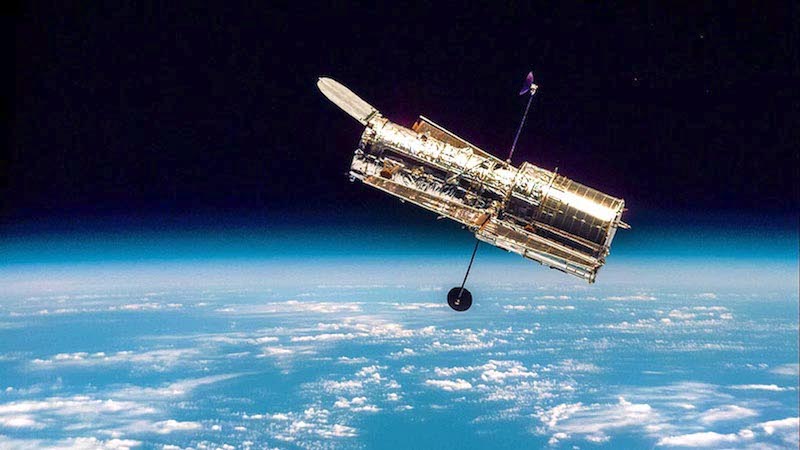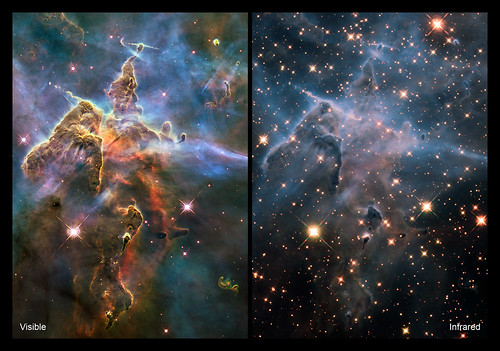
Hubble currently in safe mode. What’s next?
The Hubble Space Telescope is currently in a protective safe mode. A degrading computer memory module appears to have been the source of the halt. In safe mode, the telescope is not carrying out its regularly scheduled observing program. It’s not pointing toward targets or collecting data, but the telescope stays powered via its solar panels. Hubble has been idle since June 13, 2021. NASA first announced the safe mode on June 16. NASA’s latest report on June 30 said that:
… over the next week or so, the team will review and update all of the operations procedures, commands and other related items necessary to perform the switch to backup hardware.
Flight controllers from NASA’s Goddard Space Flight Center tried restarting Hubble on Monday, June 21, but the attempt was unsuccessful. The current is to try to restart a backup memory unit. This backup hasn’t been powered on since its install back in 2009 but was thoroughly tested on the ground. NASA performed a similar switch just a year prior in 2008, which was a success and allowed Hubble to continue normal science operations, after a previous module failed.
NASA wrote on the source of the computer problem:
The team is currently scrutinizing the Command Unit/Science Data Formatter (CU/SDF), which sends and formats commands and data. They are also looking at a power regulator within the Power Control Unit, which is designed to ensure a steady voltage supply to the payload computer’s hardware. If one of these systems is determined to be the likely cause, the team must complete a more complicated operations procedure to switch to the backup units. This procedure would be more complex and riskier than those the team executed last week, which involved switching to the backup payload computer hardware and memory modules. To switch to the backup CU/SDF or power regulator, several other hardware boxes on the spacecraft must also be switched due to the way they are connected to the SI C&DH [Science Instrument Command and Data Handling] unit.
If the backup works, Hubble will need at least one day for precautionary testing before NASA powers up its science instruments, and viewing can resume studying the universe. Until then, the cameras, instruments, and telescope itself remain healthy and in safe mode. So the telescope is fine, at least for the moment.
The decades-old computer memory module responsible for this shut-down controls the telescope’s instruments and monitors its condition. A second, backup computer is considered “fully redundant” by NASA, intended only for use in the event of an issue. Both computers can access any of Hubble’s four memory modules, and both only use one at a time. The other three modules only serve as backups, too.
The operations team at NASA’s Goddard Space Flight Center in Maryland told Space.com:
Analysis indicates the error is likely due to a degraded memory problem. Memory can degrade over time due to years of exposure to radiation in space. Issues like this are expected, which is why there are backup memory modules on the spacecraft.
Enter the James Webb Space Telescope
Since Hubble’s launch in 1990, it’s shown increased signs of aging in recent years, despite a series of repairs and updates made by astronauts to keep the telescope in good health. Prior to the current June-July 2021 safe mode, Hubble’s last safe mode incident occurred just two months ago when an onboard software program failed during a guide star acquisition in March.
That dark spell lasted five days, but Hubble rebounded in good shape.
The James Webb Space Telescope – also known as JWST or simply the Webb – is currently in development and slated for launch in November of this year. The Webb will observe farther into the infrared regions of the electromagnetic spectrum than Hubble as well as the now-decommissioned Spitzer infrared space telescope. It’ll go even deeper into space than Hubble – 1 million miles (1.6 million km) away, too far for astronaut tune-ups – and thus, it’ll look further into the past. NASA likes to say that the Webb is not a replacement for Hubble but rather a successor. As it did for Hubble, the Space Telescope Science Institute in Maryland will operate the Webb telescope after launch. The two telescopes will even collaborate side by side for a while with a planned overlap.

Significant progress was made in the Webb’s development in February this year with the success of its final functional performance tests. The two testing milestones – the comprehensive systems test and the ground segment test – confirmed that the observatory’s internal electronics are operating as intended. They also verified that its four science instruments can send and receive data, moving it closer to its highly anticipated launch date.
Webb’s launch is years behind schedule. Its latest delay – announced on June 1, during an ESA briefing – serves as a grace period for team engineers to review payload fairing problems linked to the Ariane 5 rocket it will ride. The payload fairing is essentially the rocket’s nose cone, covering on top of the payload.
Bottom line: The Hubble Space Telescope is currently in a protective safe mode with indications pointed to a degrading computer memory module as the source of the halt. It’s been idle since June 13, 2021, around 4 p.m. EDT (20 UTC), first announced in a NASA statement on June 16. NASA’s latest report is that “the team is currently designing tests that will be run in the next few days to attempt to further isolate the problem and identify a potential solution.”
Read more from EarthSky: Webb Space Telescope launch delayed
The post Hubble in safe mode, might run on backup computer first appeared on EarthSky.
from EarthSky https://ift.tt/2Umul1t

Hubble currently in safe mode. What’s next?
The Hubble Space Telescope is currently in a protective safe mode. A degrading computer memory module appears to have been the source of the halt. In safe mode, the telescope is not carrying out its regularly scheduled observing program. It’s not pointing toward targets or collecting data, but the telescope stays powered via its solar panels. Hubble has been idle since June 13, 2021. NASA first announced the safe mode on June 16. NASA’s latest report on June 30 said that:
… over the next week or so, the team will review and update all of the operations procedures, commands and other related items necessary to perform the switch to backup hardware.
Flight controllers from NASA’s Goddard Space Flight Center tried restarting Hubble on Monday, June 21, but the attempt was unsuccessful. The current is to try to restart a backup memory unit. This backup hasn’t been powered on since its install back in 2009 but was thoroughly tested on the ground. NASA performed a similar switch just a year prior in 2008, which was a success and allowed Hubble to continue normal science operations, after a previous module failed.
NASA wrote on the source of the computer problem:
The team is currently scrutinizing the Command Unit/Science Data Formatter (CU/SDF), which sends and formats commands and data. They are also looking at a power regulator within the Power Control Unit, which is designed to ensure a steady voltage supply to the payload computer’s hardware. If one of these systems is determined to be the likely cause, the team must complete a more complicated operations procedure to switch to the backup units. This procedure would be more complex and riskier than those the team executed last week, which involved switching to the backup payload computer hardware and memory modules. To switch to the backup CU/SDF or power regulator, several other hardware boxes on the spacecraft must also be switched due to the way they are connected to the SI C&DH [Science Instrument Command and Data Handling] unit.
If the backup works, Hubble will need at least one day for precautionary testing before NASA powers up its science instruments, and viewing can resume studying the universe. Until then, the cameras, instruments, and telescope itself remain healthy and in safe mode. So the telescope is fine, at least for the moment.
The decades-old computer memory module responsible for this shut-down controls the telescope’s instruments and monitors its condition. A second, backup computer is considered “fully redundant” by NASA, intended only for use in the event of an issue. Both computers can access any of Hubble’s four memory modules, and both only use one at a time. The other three modules only serve as backups, too.
The operations team at NASA’s Goddard Space Flight Center in Maryland told Space.com:
Analysis indicates the error is likely due to a degraded memory problem. Memory can degrade over time due to years of exposure to radiation in space. Issues like this are expected, which is why there are backup memory modules on the spacecraft.
Enter the James Webb Space Telescope
Since Hubble’s launch in 1990, it’s shown increased signs of aging in recent years, despite a series of repairs and updates made by astronauts to keep the telescope in good health. Prior to the current June-July 2021 safe mode, Hubble’s last safe mode incident occurred just two months ago when an onboard software program failed during a guide star acquisition in March.
That dark spell lasted five days, but Hubble rebounded in good shape.
The James Webb Space Telescope – also known as JWST or simply the Webb – is currently in development and slated for launch in November of this year. The Webb will observe farther into the infrared regions of the electromagnetic spectrum than Hubble as well as the now-decommissioned Spitzer infrared space telescope. It’ll go even deeper into space than Hubble – 1 million miles (1.6 million km) away, too far for astronaut tune-ups – and thus, it’ll look further into the past. NASA likes to say that the Webb is not a replacement for Hubble but rather a successor. As it did for Hubble, the Space Telescope Science Institute in Maryland will operate the Webb telescope after launch. The two telescopes will even collaborate side by side for a while with a planned overlap.

Significant progress was made in the Webb’s development in February this year with the success of its final functional performance tests. The two testing milestones – the comprehensive systems test and the ground segment test – confirmed that the observatory’s internal electronics are operating as intended. They also verified that its four science instruments can send and receive data, moving it closer to its highly anticipated launch date.
Webb’s launch is years behind schedule. Its latest delay – announced on June 1, during an ESA briefing – serves as a grace period for team engineers to review payload fairing problems linked to the Ariane 5 rocket it will ride. The payload fairing is essentially the rocket’s nose cone, covering on top of the payload.
Bottom line: The Hubble Space Telescope is currently in a protective safe mode with indications pointed to a degrading computer memory module as the source of the halt. It’s been idle since June 13, 2021, around 4 p.m. EDT (20 UTC), first announced in a NASA statement on June 16. NASA’s latest report is that “the team is currently designing tests that will be run in the next few days to attempt to further isolate the problem and identify a potential solution.”
Read more from EarthSky: Webb Space Telescope launch delayed
The post Hubble in safe mode, might run on backup computer first appeared on EarthSky.
from EarthSky https://ift.tt/2Umul1t

Aucun commentaire:
Enregistrer un commentaire